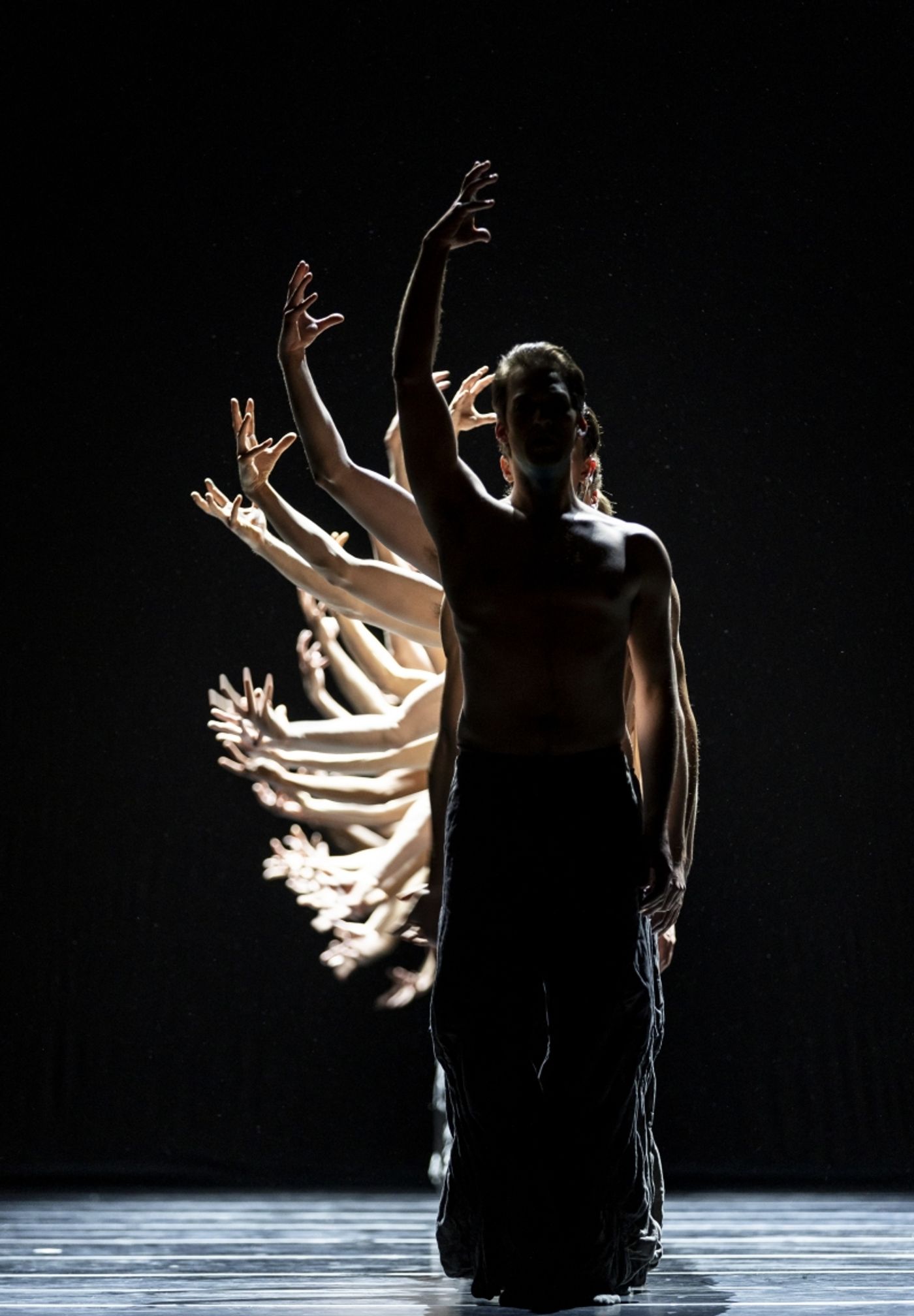Review: THE SEASONS' CANON at Pacific Northwest Ballet
The production runs through April 21st.


Miles Pertl with company dancers
in Crystal Pite's The Seasons' Canon
Photo (c) Angela Sterling
The very first notes of Max Richter’s recomposition of Vivaldi’s “Four Seasons” silenced the audience at McCaw Hall on Saturday evening into a churchlike reverie.
Canadian choreographer Crystal Pite’s “The Seasons’ Canon,” the final piece in the triple bill rep of the same name, opens on a mound of dancers clad in genderless, earth-toned pants and flesh-colored tops gently undulating in unison beneath a black backdrop spotlit with dappled orange light. With the rising curtain, “Spring” had come to Pacific Northwest Ballet, new life abounding in the emergence of individual dancers as they lifted out of the swaying group and peered around the stage. The piece was an immediate Seattle favorite when it made its PNB debut last season and is cleverly woven together with works by American choreographers Twyla Tharp and Jessica Lang to create an evening of contemporary dance that awakens the divine in sleepy Pacific Northwest spirits.
The program opens with American icon Twyla Tharp’s 1996 creation, “Sweet Fields™”, set to 18th and 19th century American hymns performed by Seattle’s Tudor Choir. Twelve dancers in simple white dress perform a combination of classical ballet, albeit barefoot, dotted here and there with unexpected movements. Shaking hands reminiscent of Shaker prayer gesticulations, little booty wiggles, and gazes pointed directly at the audience elicited awkward giggles from viewers. Tharp’s work is like this: complicated technical dance steps mixed with pedestrian movements is a hallmark of her groundbreaking choreography that has shaped American ballet and contemporary dance since her emergence in the 1960s. While PNB’s dancers performed the intricate choreography with flawless technical skill, the piece lacked the company’s usual artistic depth and some of the more complicated lifts and tricks appeared to sacrifice fluidity for successful execution. However, the fiery performance by soloist Kuu Sakuragi grounded the piece with passionate, impossibly graceful leaps, some of which appeared to suspend Sakuragi in mid-flight as if he were making physical contact with the divine.
“The Calling,” a four minute solo piece by PNB’s next resident choreographer Jessica Lang, is also a returning favorite. Performed Saturday night by soon-to-retire principal dancer James Yoichi Moore, “The Calling” has never seemed to me like a piece to be witnessed, but more a private moment of grief and redemption the audience is privileged to glimpse.
Created by Lang after receiving a letter from a deceased mentor, “The Calling” features a single dancer wearing a thin but dramatic white skirt that extends from the dancer’s waist almost to the edges of the stage. Moore is perfectly cast in this role, his chiseled upper body stretched beseechingly upward toward a sharp spotlight as if in prayer. As he slowly moved his torso into occasional deep plies and clockwise rotations, Moore’s skirt wrapped around his legs so he appeared to be a floating apparition of strength, grief, and gratitude.

in Jessica Lang's The Calling
Photo (c) Lindsay Thomas
The whole “Seasons’ Canon” program is a communion of spirit and community, without specific creed or deity other than the simple acknowledgement of the magic of nature. Tharp’s piece highlights the sacred in community as the dancers carry each other across the stage. Lang’s solo work offers a piece of the choreographer’s own spirit to her audiences through a physical demonstration of the duality of love and grief. And the titular work, Pite’s genius display of Mother Earth through dance, is a piece that even new or skeptical ballet goers must see.
At times, the fortyish dancers in “Seasons Canon” do not appear to be human but perform as a mass of energy, arms moving in perfect illustration of mycelium, or wind, or emerging insects from the ground. Max Richter’s recomposition of Vivaldi’s classic “Four Seasons” inserts deeper, darker notes and longer pauses into the phrasing, drawing out the dark mystery of changing seasons. With the natural, social, and political worlds in upheaval at the present moment across the world, “The Seasons’ Canon” offers a safe haven for deeply feeling arts lovers to take a safe seat for a couple of hours and experience our powerful and merciful natural world through the medium of dance.
Approximate Running Time: 1 hour and 30 minutes, including one 25 minute intermission.
“The Seasons’ Canon” performs at McCaw Hall through April 21st. For tickets or information visit them online at www.pnb.org/season/the-seasons-canon/.
Reader Reviews
Videos

